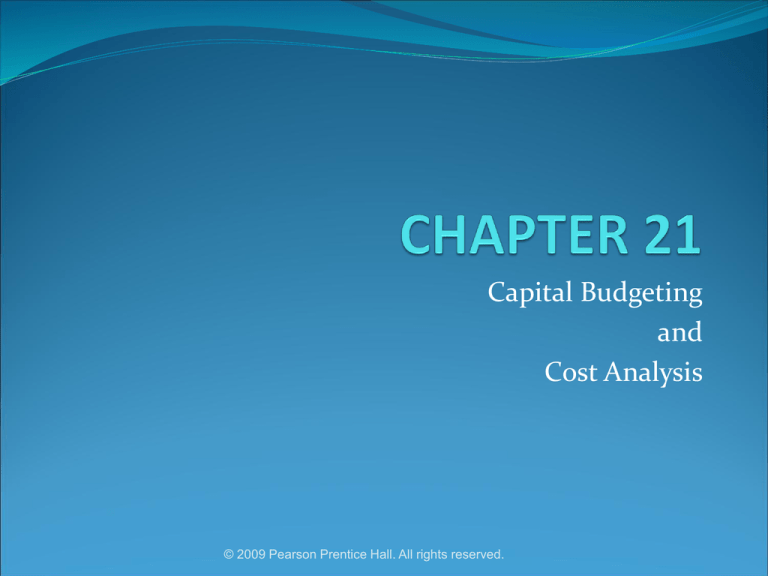
Capital Budgeting
and
Cost Analysis
© 2009 Pearson Prentice Hall. All rights reserved.
Two Dimension of Cost Analysis
Project-by-Project Dimension: one project spans
multiple accounting periods
Period-by-Period Dimension: one period contains
multiple projects
© 2009 Pearson Prentice Hall. All rights reserved.
Project and Time Dimensions of
Capital Budgeting Illustrated
© 2009 Pearson Prentice Hall. All rights reserved.
Capital Budgeting
Capital Budgeting is making a long-run planning
decisions for investing in projects
Capital Budgeting is a decision-making and control
tool that spans multiple years
© 2009 Pearson Prentice Hall. All rights reserved.
Six Stages in Capital Budgeting
1.
2.
Identification Stage – determine which types of
capital investments are necessary to accomplish
organizational objectives and strategies
Search Stage – Explore alternative capital
investments that will achieve organization
objectives
© 2009 Pearson Prentice Hall. All rights reserved.
Six Stages in Capital Budgeting:
Continued
Information-Acquisition Stage – consider the
expected costs and benefits of alternative capital
investments
4. Selection Stage – choose projects for
implementation
5. Financing Stage – obtain project financing
6. Implementation and Control Stage – get projects
under way and monitor their performance
3.
© 2009 Pearson Prentice Hall. All rights reserved.
Four Capital Budgeting Methods
1.
2.
3.
4.
Net Present Value (NPV)
Internal Rate of Return (IRR)
Payback Period
Accrual Accounting Rate of Return (AARR)
© 2009 Pearson Prentice Hall. All rights reserved.
Discounted Cash Flows
Discounted Cash Flow (DCF) Methods measure all
expected future cash inflows and outflows of a project
as if they occurred at a single point in time
The key feature of DCF methods is the time value of
money (interest), meaning that a dollar received today
is worth more than a dollar received in the future
© 2009 Pearson Prentice Hall. All rights reserved.
Discounted Cash Flows (continued)
DCF methods use the Required Rate of Return
(RRR), which is the minimum acceptable annual rate
of return on an investment.
RRR is the return that an organization could expect
to receive elsewhere for an investment of comparable
risk
RRR is also called the discount rate, hurdle rate, cost
of capital or opportunity cost of capital
© 2009 Pearson Prentice Hall. All rights reserved.
Net Present Value (NPV) Method
NPV method calculates the expected monetary gain or
loss from a project by discounting all expected future
cash inflows and outflows to the present point in time,
using the Required Rate of Return
Based on financial factors alone, only projects with a
zero or positive NPV are acceptable
© 2009 Pearson Prentice Hall. All rights reserved.
Three-Step NPV Method
Draw a sketch of the relevant cash inflows
and outflows
2. Convert the inflows and outflows into
present value figures using tables or a
calculator
3. Sum the present value figures to determine
the NPV. Positive or zero NPV signals
acceptance, negative NPV signals rejection
1.
© 2009 Pearson Prentice Hall. All rights reserved.
NPV Method Illustrated
© 2009 Pearson Prentice Hall. All rights reserved.
Internal Rate of Return (IRR) Method
The IRR Method calculates the discount rate at which
the present value of expected cash inflows from a
project equals the present value of its expected cash
outflows
A project is accepted only if the IRR equals or exceeds
the RRR
© 2009 Pearson Prentice Hall. All rights reserved.
IRR Method
Analysts use a calculator or computer program to
provide the IRR
Trial and Error Approach:
Use a discount rate and calculate the project’s NPV. Goal:
find the discount rate for which NPV = 0
1.
2.
3.
If the calculated NPV is greater than zero, use a higher
discount rate
If the calculated NPV is less than zero, use a lower discount
rate
Continue until NPV = 0
© 2009 Pearson Prentice Hall. All rights reserved.
IRR Method Illustrated
© 2009 Pearson Prentice Hall. All rights reserved.
Comparison NPV and IRR Methods
IRR is widely used
NPV can be used with varying RRR
NPV of projects may be combined for evaluation
purposes, IRR cannot
Both may be used with sensitivity analysis (“what-if”
analysis)
© 2009 Pearson Prentice Hall. All rights reserved.
Sensitivity Analysis Illustration
© 2009 Pearson Prentice Hall. All rights reserved.
Payback Method
Payback measures the time it will take to recoup, in
the form of expected future cash flows, the net initial
investment in a project
Shorter payback period are preferable
Organizations choose a project payback period. The
greater the risk, the shorter the payback period
Easy to understand
© 2009 Pearson Prentice Hall. All rights reserved.
Payback Method Continued
With uniform cash flows:
Payback
Period
=
Net Initial Investment
Uniform Increase in Annual Future Cash Flows
With non-uniform cash flows: add cash flows period-
by-period until the initial investment is recovered;
count the number of periods included for payback
period
© 2009 Pearson Prentice Hall. All rights reserved.
Accrual Accounting Rate of Return Method
(AARR)
AARR Method divides an accrual accounting measure
of average annual income of a project by an accrual
accounting measure of its investment
Also called the Accounting Rate of Return
© 2009 Pearson Prentice Hall. All rights reserved.
AARR Method Formula
Accrual Accounting
Rate of Return
=
Increase in Expected Average
Annual After-Tax Operating Income
Net Initial Investment
© 2009 Pearson Prentice Hall. All rights reserved.
AARR Method
Firms vary in how they calculate AARR
Easy to understand, and use numbers reported in
financial statements
Does not track cash flows
Ignores time value of money
© 2009 Pearson Prentice Hall. All rights reserved.
Evaluating Managers and
Goal-Congruence Issues
Some firms use NPV for capital budgeting decisions
and a different method for evaluating performance
Managers may be tempted to make capital budgeting
decisions on the basis of short-run accrual accounting
results, even though that would not be in the best
interest of the firm
© 2009 Pearson Prentice Hall. All rights reserved.
Relevant Cash Flows in
DCF Analysis
Relevant cash flows are the differences in expected
future cash flows as a result of making an
investment
Categories of Cash Flows:
Net Initial Investment
2. After-tax cash flow from operations
3. After-tax cash flow from terminal disposal of an asset
and recovery of working capital
1.
© 2009 Pearson Prentice Hall. All rights reserved.
Net Initial Investment
1.
2.
3.
Three Components:
Initial Machine Investment
Initial Working Capital Investment
After-tax Cash Flow from Current Disposal of Old
Machine
© 2009 Pearson Prentice Hall. All rights reserved.
Cash Flow from Operations
1.
2.
Two Components:
Inflows (after-tax) from producing and selling
additional goods or services, or from savings in
operating costs. Excludes depreciation, handled
below:
Income tax cash savings from annual depreciation
deductions
© 2009 Pearson Prentice Hall. All rights reserved.
Terminal Disposal of Investment
1.
2.
Two Components:
After-tax cash flow from terminal disposal of asset
(investment)
After-tax cash flow from recovery of working capital
(liquidating receivables and inventory once needed
to support the project)
© 2009 Pearson Prentice Hall. All rights reserved.
Cash Flow Effects From Investment
Decisions, Illustrated
© 2009 Pearson Prentice Hall. All rights reserved.
Cash Flow Effects From Investment
Decisions, Illustrated
© 2009 Pearson Prentice Hall. All rights reserved.
Managing the Project
Implementation and Control:
Management of the investment activity itself
Management control of the project as a whole
A post-investment audit may be done to provide
management with feedback about the performance of
a project, so that management can compare actual
results to the costs and benefits expected at the time
the project was selected
© 2009 Pearson Prentice Hall. All rights reserved.
Strategic Considerations in
Capital Budgeting
A company’s strategy is the source of its strategic
capital budgeting decisions
Some firms regard R&D projects as important strategic
investments
Outcomes very uncertain
Far in the future
© 2009 Pearson Prentice Hall. All rights reserved.
© 2009 Pearson Prentice Hall. All rights reserved.








